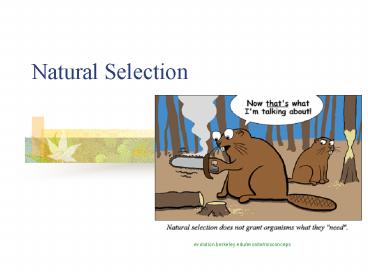Natural Selection - PowerPoint PPT Presentation
1 / 20
Title:
Natural Selection
Description:
Genetic equilibrium - frequency of alleles remains same over generations = no evolution ... when populations change as they adapt to different environmental conditions ... – PowerPoint PPT presentation
Number of Views:19
Avg rating:3.0/5.0
Title: Natural Selection
1
Natural Selection
evolution.berkeley.edu/evosite/misconceps
2
Charles Darwin (1809-1882)
- Naturalist aboard HMS Beagle
- Collected living specimens fossils
- Visited Galapagos Islands (p.394, fig. 15.1)
- Tortoises
- Finches
- Marine iguanas
- Bred pigeons artificial selection
http//nayagam.files.wordpress.com/2006/02/397px-C
harles_Darwin_by_G._Richmond.jpg
3
Darwin cont.
- From collections observations
- Natural selection
- Mechanism for change in populations
- Organisms with favorable variations survive,
reproduce, pass variations on to next
generation - Published On the Origin of Species by Means of
Natural Selection
http//uk.gizmodo.com/charles_darwin_l.jpg
4
Mechanisms of Evolution
- Populations evolve, NOT individuals
- Gene pool - all alleles in a populations genes
together (remember alleles alternative forms of
a gene) - Allelic frequency - of any specific allele
(p.405 snapdragons) - Genetic equilibrium - frequency of alleles
remains same over generations no evolution
5
How does evolution happen? - disrupting genetic
equilibrium
- Mutations - caused by radiation or chemicals
- Genetic drift - alteration of allelic frequencies
by chance events (random, affects small
populations greater) - Gene flow - Migration Emigration
- Natural selection - allelic frequencies change
due to nature selecting for advantageous
variations - Stabilizing, directional, and disruptive
6
Stabilizing selection - favors average phenotypes
- Spiders- larger spiders
- eaten by predators
- -Smaller spiders cant
- catch enough food
- -Favors average size
7
Directional selection - favors one extreme (on
graph, selects to left or right)
- Woodpeckers-
- longer beaks
- eat more insects
- buried deep in bark
- (have more fitness)
- Long beaks favored
- Can lead to
- rapid evolution
8
Disruptive selection - eliminates intermediate
phenotypes
- In an environment,
- medium-sized seeds
- become less common
- -Birds with smaller or
- larger beaks have easier
- time finding food
- higher fitness
9
How do changes in gene pool lead to evolution?
- Speciation - when members of similar populations
no longer interbreed to produce fertile offspring
within natural environment - Geographic isolation - physical barrier divides a
population - Lava from volcanic eruptions, sea-level changes,
rivers, mountains - Reproductive isolation - populations no longer
mate and produce fertile offspring - Behavorial - different mating calls or seasons
- Different genetic material
- Polyploidy - having multiple chromosome sets
10
Speciation rates - 2 hypotheses, both supported
by fossil record
- Gradualism - species originate through gradual
change of adaptations slow steady - Punctuated equilibrium - species originate
quickly, in rapid bursts
11
Patterns of evolution
- Divergent evolution - occurs when populations
change as they adapt to different environmental
conditions - Adaptive radiation - ancestral species evolves
into many new species to fit various niches - Hawaiiian honeycreepers Darwins finches
- Convergent evolution - unrelated species evolve
similar traits because of similar environmental
pressures - Different cactus species around the world
12
Adaptations Evidence for Evolution
- Structural adaptations
- Body parts of an organism that help it survive
- Ex. Teeth, claws, keen eyes, thorns,
- Mimicry more subtle
- One harmless species looks a dangerous one
- Harmless fly looks like a wasp scarlet kingsnake
looks like coral snake - Two or more harmful species look alike
- Yellow jackets, honeybees, many wasps use same
coloring to say Hey, stay away, Ill hurt you! - Camouflage enables species to blend in
13
lh3.google.ca/abramsv
www.nature.com/.../n7023/images/433205a-f1
farm1.static.flickr.com/144/383488615_b937af4
Photo Credit AZ Herpetological
Associationhttp//www.sloanmonster.com/images/cor
al.jpg
Photo Credit Dan Hipeshttp//www.outdooralabama.
com/watchable2Dwildlife/what/Reptiles/Snakes/scar
let.cfm
14
- Can you think of an example for camouflage?
- Ill show you some
15
Physiological adaptations
- Can happen very quickly
- Changes in an organisms metabolic processes
- Antibiotic-resistance bacteria
- Penicillin not as effective now
- Insects weeds resistant to pesticides
16
Articles on -Antibiotic resistance
-Crop pest evolution MRSA podcast
Strains of drug-resistant TB
17
Indirect evidence for evolution
- Fossils
- Assembling a puzzle without all the pieces
- What percentage of Lucy did they find?
18
Indirect evidence for evolution
- Anatomy (p. 401 fig. 15.6)
- Homologous structures
- Structural features with common evolutionary
origin
http//evolution.berkeley.edu/evosite/lines/IIhomo
logies.shtml
19
Anatomy cont.
http//evolution.berkeley.edu/evolibrary/article//
evo_31
- Analogous structures
- Body parts have similar function but not common
ancestry - Bird wing, butterfly wing
- Vestigial structures
- Body part in present-day organism that no longer
serves its original purpose (but was useful at
some time) - Our wisdom teeth, appendix, blind cave fish with
eyes
20
Indirect Evidence for Evolution
- Embryology
- Embryo earliest stage of growth development
of plants animals - Page 402 fig. 15.9 You had a tail and gills??
- Biochemistry
- Biochemical molecules RNA, DNA, ATP, and many
enzymes - Compare amino acid sequences among organisms
- Enzyme - cytochrome c - involved in cellular
respiration - P.403

